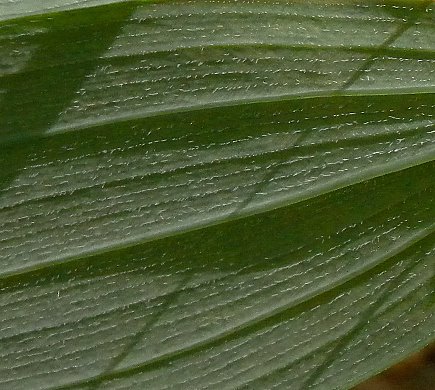
The blooming period occurs from mid- to late spring, lasting about 3 weeks. During the summer, the flowers are replaced by berries. At maturity, these berries are dark blue-violet to black, globoid in shape, and often glaucous; they are 6-9 mm. across. The interior of these berries is fleshy with several seeds. Individual seeds are 1.5-3.0 mm. long, globoid in shape, and either tan or straw-colored. The root system has knotty rhizomes up to ½" thick. Small clonal colonies are often produced from these rhizomes.
Cultivation: The preference is partial sun to medium shade, moist conditions, and soil containing either loam or sandy loam with decaying organic matter. Most growth and development occurs during the cool weather of spring.

Range & Habitat: The native Hairy Solomon's Seal is rare in northern Illinois, while in the rest of the state it is absent (Distribution Map). It is state-listed as 'endangered.' Illinois lies along the southern range limit of this species (excluding mountainous areas in the Appalachians). Habitats include moist to mesic woodlands, sandy woodlands, and lower slopes of forested sand dunes near Lake Michigan. In Illinois, Hairy Solomon's Seal is found in higher quality natural areas.
Faunal Associations: The flowers attract the Ruby-throated Hummingbird, honeybees, bumblebees, and probably other bees. These floral visitors feed primarily on the nectar, although some of the bees also collect pollen for their larvae. A small number of insects feed destructively on the foliage and plant juices of Polygonatum spp. (Solomon's Seal species). These insects include the aphids Catamergus kickapoo and Macrosiphum gei, the thrips Ctenothrips bridwelli, and caterpillars of the moth Clepsis melaleucana (Black-Patched Clepsis). The berries are probably eaten by such woodland birds as the Ruffed Grouse, various thrushes, and the Veery. These birds spread the seeds to new areas. White-tailed Deer occasionally graze on the foliage of Solomon's Seal species.

Photographic Location: A moist sandy woodland at the Indiana Dunes State Park in NW Indiana.
Comments: This species can be easily confused with the more common Polygonatum commutatum (Smooth Solomon's Seal). Hairy Solomon's Seal tends to be a smaller plant that produces fewer flowers and berries underneath its leaves (usually only 1-2 flowers or berries per leaf). It also has a tendency to bloom a little earlier in the year than the latter plant. However, the most distinctive characteristics of Hairy Solomon's Seal are 1) the short fine hairs along the veins of its leaf undersides, and 2) the warty filaments of its flowers.